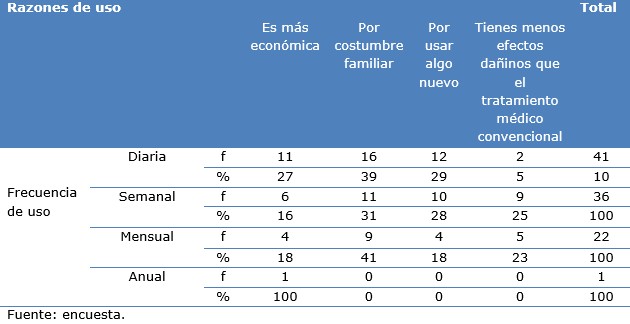Uso de la medicina no convencional por pacientes diabéticos
Resumen
Fundamento: el interés en las terapias alternativas utilizadas por las personas con diferentes enfermedades ha crecido de manera considerable en los últimos tiempos. Se estima que un gran porcentaje de las personas en regiones menos desarrolladas emplean la medicina tradicional con plantas para el cuidado de la salud.
Objetivo: determinar el uso de medicina no convencional en pacientes diabéticos.
Métodos: se realizó un estudio observacional descriptivo de corte transversal, dirigido a pacientes que pertenecen al club de diabéticos del Centro Clínico Quirúrgico Hospital del Día Santo Domingo, Ecuador, desde el 5 de junio hasta el 31 de julio de 2018. La población universo estuvo compuesta de 1 300 personas. De acuerdo a los criterios de inclusión y exclusión. Se obtuvo una muestra de 100 personas a las cuales se les aplicó la encuesta como instrumento de investigación.
Resultados: se identificó que el sexo femenino fue el que más predominó. De esta población la mayor parte utiliza la medicina no convencional por costumbres familiares. La fitoterapia fue la más conocida y más empleada por los pacientes diabéticos. Las plantas medicinales de mayor uso fueron: Insulina (Costus igneus) y la Zarzgoza (Glycyrrhiza glabra).
Conclusiones: se constató que la población diabética hace uso de la medicina no convencional para el tratamiento de su enfermedad, la misma en pocas ocasiones es recomendada por el médico, aunque no se notificaron efectos adversos algunos, la fitoterapia y la acupuntura son las más utilizadas.
DeCS: MEDICINA TRADICIONAL; DIABETES MELLITUS/terapia; FITOTERAPIA; TERAPIA POR ACUPUNTURA; ESTUDIO OBSERVACIONAL.
Descargas
Citas
1. Padavala Ajay B, Gadde S, Radha B, Vedurupaka VL, Talluru Sudha R, Yellapu Ram B, et al. A database of 389 medicinal plantsfor diabetes. Bioinformation [Internet]. 2006 [citado 16 Jun 2019];4:[aprox. 2 p.]. Disponible en: https://www.ncbi.nlm.nih.gov/pmc/articles/PMC1891668/.
2. Beyra A, León MC, Iglesias E, Ferrándiz D, Herrera R, Volpato G, et al. Estudios etnobotánicos sobre plantas medicinales en la provincia de Camaguey (Cuba). Anal jard Botán Madrid [Internet]. 2004 [citado 16 Jun 2019];61(12):[aprox. 22 p.]. Disponible en: http://rjb.revistas.csic.es/index.php/rjb/article/view/44/44
3. Koren R, Lerner A, Tirosh A, Zaidenstein R, Ziv Baran T, Golik A, et al. The Use of Complementary and Alternative Medicine in Hospitalized Patients with Type 2 Diabetes Mellitus in Israel. J Altern Complem Med [Internet]. Jun 2015 [citado 16 Jun 2019];21(7):[aprox. 6 p.]. Disponible en: https://www.liebertpub.com/doi/full/10.1089/acm.2015.0019
4. Hernando Pertierra B. Libro Blanco de los herbolarios y plantas medicinales. [Internet]. España:Fundación Salud y Naturaleza (S.N.);2007 [citado 16 Jun 2019]. Disponible en: https://www.fitoterapia.net/archivos/200 701/260307libro-2.pdf?1
5. Morales Mesa A. El uso popular de las plantas medicinales: tres puntos de vista y un objetivo común. La Habana: Centro de Investigaciones Psicológicas y Sociológicas; 2000 [citado 16 Jun 2019]. Disponible en: http://biblioteca.clacso.edu.ar/Cuba/cips/20120823104522/morales1.pdf
6. Cano Rodríguez I, Ballesteros Pomar MD. Terapias alternativas en diabetes. Endocrinol Diabetes Nutr [Internet]. 2018 [citado 16 Jun 2019];65(4):189-244.
7. Pinto CE. Influencia de la medicina tradicional frente al tratamiento de la diabetes mellitus. Rev Saluta [Internet]. 2018 [citado 16 Jun 2019];1(1):[aprox. 9 p.]. Disponible en: https://revistas.umecit.edu.pa/index.php/saluta/article/download/157/233/.
8. International Diabetes Federation [Internet]. Belgium: ©2019 International Diabetes Federation [actualizado 14 Nov 2019; citado 16 Jun 2019]. New IDF figures show continued increase in diabetes across the globe, reiterating the need for urgent action. Noviembre 2017; [aprox. 12 pantallas]. Disponible en: https://www.idf.org/news/94:new-idf-figures-show-continued-increase-in-diabetes-across-the-globe,-reiterating-the-need-for-urgent-action.html
9. Ledón Llanes L. Impacto psicosocial de la diabetes mellitus, experiencias, significados y respuestas a la enfermedad. Rev Cubana Endocrinol [Internet]. Abr 2012 [citado 16 Jun 2019];23(1):[aprox. 21 p.]. Disponible en: http://scielo.sld.cu/scielo.php?script=sci_arttext&pid=S1561-29532012000100007&lng=es
10. Hernández Sampieri R, Fernández Collado C, Baptista Lucio P. Metodología de la Investigación. 6ta edición. México: Mc Graw Hill;2014.
11. Lancheros Páez L, Pava Cárdenas A, Bohórquez Poveda A. Identificación de la adherencia al tratamiento nutricional aplicando el modelo de Conocimientos, Actitudes y Prácticas en un grupo de personas con Diabetes Mellitus tipo 2 atendidas en la Asociación Colombiana de Diabetes. Diaeta [Internet]. Dic 2010 [citado 16 Jun 2019];28(133):[aprox. 7 p.]. Disponible en: http://www.scielo.org.ar/scielo.php?script=sci_arttext&pid=S1852-73372010000400003&lng=es
12. Vicente Sánchez B, Bonilla Romero J, Vicente Peña E, Costa Cruz M, Zerquera Trujillo G. Percepción de riesgo de desarrollar diabetes mellitus en personas no diabéticas. Rev. Finlay [Internet]. Jun 2016 [citado 16 Jun 2019];6(2):[aprox. 12 p.]. Disponible en: http://scielo.sld.cu/scielo.php?script=sci_arttext&pid=S2221-24342016000200002&lng=es
13. Leiva AM, Martínez MA, Petermann F, Garrido Méndez A, Poblete Valderrama F, Díaz Martínez X, et al. Factores asociados al desarrollo de diabetes mellitus tipo 2 en Chile. Nutr Hosp [Internet]. Abr 2018 [citado 16 Jun 2019];35(2):[aprox. 8 p.]. Disponible en: http://scielo.isciii.es/scielo.php?script=sci_arttext&pid=S0212-16112018000200400&lng=es
14. Soares Lima A, Moura Araujo M, Freire de Freitas R, Zanetti M, De Almeida P, Coelho Damasceno M. Factores de riesgo para Diabetes Mellitus Tipo 2 en universitarios: asociación con variables sociodemográficas. Rev Latino-Am Enfermagem [Internet]. 2014 [citado 16 Jun 2019];22(3):[aprox. 6 p.]. Disponible en: http://www.scielo.br/pdf/rlae/v22n3/es_0104-1169-rlae-22-03-00484.pdf
15. Maidana M, Gonzales J, Degen de Arrúa R. Plantas medicinales empleadas por pacientes diabéticos en Paraguay. Rev Infarma. 2015;27(4):214-220.
16. Colimba Almeida J. Conocimientos y uso de plantas medicinales como parte del tratamiento de los pacientes del club de diabéticos; Hospital San Vicente de Paúl. [Tesis]. Ecuador: Universidad Técnica Del Norte; 2016 [citado 16 Jun 2019]. Disponible en: http://repositorio.utn.edu.ec/bitstream/123456789/6886/1/06%20NUT%20213%20TRABAJO%20DE%20GRADO.pdf
17. Torres Camacho V, Castro Cañaviri AE. Fitoterapia. Rev Act Clin Med [Internet]. 2014 [citado 16 Jun 2019];42(1):[aprox. 5 p.]. Disponible en: http://www.revistasbolivianas.org.bo/pdf/raci/v42/v42_a01.pdf
18. Gallego Muñoz C, Ferreira Alfaya J. Platas medicinales en el tratamiento de la Diabetes Mellitus tipo 2: una revisión. Rev OFIL [Internet]. Dic 2015 [citado 16 Jun 2019];27(3):27-34.
19. Acosta Recalde P, Zully Vera G, Morinigo M, Maidana GM, Samaniego L. Use of medicinal plants and phytotherapic compounds in patients with Diabetes Mellitus type 2. Mem Inst Investig Cienc Salud [Internet]. 2018 Aug [citado 16 Jun 2019];16(2):[aprox. 6 p.]. Disponible en: http://scielo.iics.una.py/scielo.php?script=sci_arttext&pid=S1812-95282018000200006&lng=en
20. Avello LM, Cisternas FI. Fitoterapia, sus orígenes, características y situación en Chile. Rev méd Chile [Internet]. Oct 2010 [citado 16 Jun 2019];138(10):[aprox. 6 p.]. Disponible en: https://scielo.conicyt.cl/scielo.php?script=sci_arttext&pid=S0034-98872010001100014&lng=es
21. Reddy Peasari J, Sri Motamarry S, Srinivasa Varma K, Ravindra Babu Pott PA. Chromatographic analysis of phytochemicals in Costusigneus and computational studies of flavonoids. Inform Med Unlocked [Internet]. 2018;13 (1):34-40.
22. Swarnalath Y, Ramesh Kumar G. Hypoglycemic effect and finger printing analysis of Costusigneus partially purified fraction in L6 cells. Int J Pharmacogn Phytochem Res [Internet]. 2015 [citado 16 Jun 2019];7(4):[aprox. 4 p.]. Disponible en: https://www.scopus.com/record/display.uri?eid=2-s2.0-84943273968&origin=resultslist&sort=plf-f&src=s&st1=costus+igneus&st2=&sid=e3b 9e9c38d1917b2cc3e7f662e78a179&sot=b&sdt=b&sl=28&s=TITLE-ABS-KEY%28c ostus+igneus%29&relpos=5&citeCnt=0&searchTerm=
23. Saravanan A, Karunakaran S, Vivek P, Dhanasekaran S. Studies on antibacterial activity of root extract of costusigneus. Intern J Chem Tech Res [Internet]. 2014 [citado 16 Jun 2019];6(9):[aprox. 6 p.]. Disponible en: https://www.scopus.com/record/display.uri?eid=2-s2.0-84907829553&orig in=resultslist&sort=plf-f&src=s&st1=costus+igneus&st2=&sid=e3b9e9c38d1917b 2 cc3e 7f662e78a179&sot=b&sdt=b&sl=28&s=TITLE-ABS-KEY%28costus+igneus %29&re lpos =10&citeCnt=1&searchTerm=
24. Guzmán Maldonado SH, Díaz Huacuz RS, González Chavira MM. Plantas medicinales: La realidad de una tradición ancestral. Inst Nac de Investigaciones Forestales, Agrícolas y Pecuarias [Internet]. Nov 2017 [citado 16 Jun 2019];1:[aprox. 17 p.]. Disponible en: http://biblioteca.inifap.gob.mx:8080/jspui/bitstream/handle/123456789/4428/4729%20Plantas%20medicinales%20la%20realidad%20de%20una%20tradici%C3%B3n%20ancestral.pdf?sequence=1
25. Hegde P, Rao H, Rao P. A review on Insulin plant (CostusigneusNak). Pharmacogn Rev. 2014;8(15):67-72.
26. Chetty S, Adiga S, Reddy S. Evaluation of the effect of costusigneus on learning and memory in normal and diabetic rats using passive avoidance task . Int J Pharm Pharm Sciences [Internet]. 2014 [citado 16 Jun 2019];6(2):[aprox. 3 p.]. Disponible en: https://www.scopus.com/record/display.uri?eid=2-s2.0-84896477261&origin=resultslist&sort=plf-f&src=s&st1=costus+igneus&st2=&sid=e3b 9e9c38d1917b2cc3e7f662e78a179&sot=b&sdt=b&sl=28&s=TITLE-ABS-KEY%28costus+igneus%29&relpos=13&citeCnt=0&searchTerm=
27. Cornelio Montejo GA, González Quirarte GE, Olán Vázquez CZ, Pardo Sánchez D, González Quirarte NH. Acupuntura y masaje: auxiliar en el tratamiento de pacientes con hipertensión y diabetes en el Ejido Cuitláhuac de Tacotalpa. Rev Enferm Actual Costa Rica [Internet]. 2016 [citado 16 Jun 2019];31:[aprox. 14 p.]. Disponible en: https://www.scielo.sa.cr/pdf/enfermeria/n31/1409-4568-enfermeria-31-00131.pdf
28. Gao Y, Lu G, Wang Y, Chen L, Chen R, Liang F. Prospects and Progress on the Mechanisms of Acupuncture Underlying Improvement in Diabetic Gastroparesis. Zhen Ci Yan Jiu. 2017 Aug 25;42(4):367-71.
29. Qi Z, Pang Y, Lin L, Zhang B, Shao J, Liu X, et al. Acupuncture combined with hydrotherapy in diabetes patients with mild lower-extremity arterial disease: A prospective, randomized, nonblinded clinical study. Med Sci Monit [Internet]. 2018 May [citado 16 Jun 2019];24:[aprox. 14 p.]. Disponible en: https://www.ncbi.nlm.nih.gov/pmc/articles/PMC5963737/pdf/medscimonit-24-2887.pdf
30. Verástegui Escolano C. Comparative evaluation of the therapeutic effect of metformin monotherapy with metformin and acupuncture combined therapy on weight loss and insulin sensitivity in diabetic patients. Rev Intern Acup. 2016 May 2;6:e209.
31. Lu M, Li K, Wang J. Acupuncture for distal symmetric multiple peripheral neuropathy of diabetes mellitus: a randomized controlled trial. Zhongguo zhen jiu [Internet]. 2016 May [citado 15 Jun 2019];36(5):[aprox. 4 p.]. Disponible en: https://www.scopus.com/record/display.uri?eid=2-s2.0-84988457272&origin=resultslist&sort=plf-f&src=s&st1=acupuncture+in+patients++diabetics&nlo=&nlr=&nls=&sid=d09f87eefe8a2aa74a687d74c6190ffa&sot=b&sdt=b&sl=49&s=TITLE-ABS-KEY%28acupuncture+in+patients++diabetics%29&relpos=40&citeCnt=2&searchTerm
32. Cheng MH, Hsieh CL, Wang CY, Tsai CC, Kuo CC. Complementary therapy of traditional Chinese medicine for blood sugar control in a patient with type 1 diabetes. Complement Ther Med [Internet]. 2017 Feb [citado 16 Junio 2019];30(1):[aprox. 4 p.]. Disponible en: https://www.clinicalkey.es/#!/content/playContent/1-s2.0-S0965229916301522?returnurl=https:%2F%2Flinkinghub.elsevier.com%2Fretrieve%2Fpii%2FS0965229916301522%3Fshowall%3Dtrue&referrer
33. Bayat M, Uslu N, Erdem E, Sezer Efe Y, Variyenli N, Arican F, et al. Complementary and alternative medicine used for children with type 1 diabetes mellitus. Iran J Pediatrics [Internet]. 2017 Ago [citado 16 Jun 2019];138(10):[aprox. 4 p.]. Disponible en: https://ijp.tums.pub/en/articles/11210.html

Publicado
Cómo citar
Número
Sección
Licencia
La Revista Archivo Medico Camagüey, ofrece de forma inmediata después de ser indexada en el Proyecto SciELO; acceso abierto al texto completo de los artículos bajo el principio de hacer disponible y gratuita la investigación para favorecer el intercambio del conocimiento global y coadyuvar a una mayor extensión, publicación, evaluación y uso extensivo de los artículos que se exponen pudiendo ser utilizados, sin fines comerciales, siempre y cuando se haga referencia a la fuente primaria.
Carta De Declaración De Autoría u Derechos De Autor(a)
Conflictos de intereses: los autores deberán declarar de forma obligatoria la presencia o no de conflictos de intereses en relación con la investigación presentada. (Descargar Plantilla para declarar confictos de intereses)
La Revista Archivo Médico Camagüey se encuentra bajo una
Licencia Creative Commons Reconocimiento-NoComercial 4.0 International (CC BY NC 4.0).
Esta licencia permite a otros distribuir, mezclar, ajustar y construir a partir de su obra, incluso con fines comerciales, siempre que le sea reconocida la autoría de la creación original. Esta es la licencia más servicial de las ofrecidas. Recomendada para una máxima difusión y utilización de los materiales sujetos a la licencia. La licencia completa puede consultarse en: https://creativecommons.org/licenses/












